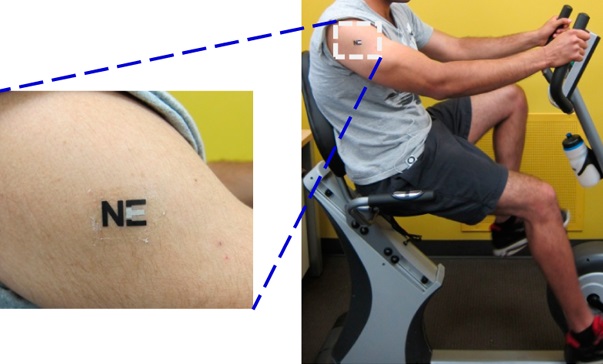Tattoo biosensor warns when athletes are about to ‘hit the wall’
July 25, 2013

(Credit: American Chemical Society)
University of California San Diego neuroengineers have developed a real-time electrochemical biosensor that can alert marathoners, competitive bikers, and other “extreme” athletes that they’re about to “bonk,” or “hit the wall.”
The sensor can be applied to the human skin like a temporary tattoo that stays on and flexes with body movements.
In ACS’ journal Analytical Chemistry, Joseph Wang and colleagues describe the first human tests of the sensor, which also could help soldiers and others who engage in intense exercise — and their trainers — monitor stamina and fitness.
Lactate monitor
The sensor monitors lactate, a form of lactic acid released in sweat. Lactate forms when the muscles need more energy than the body can supply from the “aerobic” respiration that suffices during mild exercise.
The body then shifts to “anaerobic” metabolism, producing lactic acid and lactate. That helps for a while, but lactate builds up in the body, causing extreme fatigue and the infamous “bonking out,” where an athlete just cannot continue.
Tests on 10 human volunteers showed that the sensor accurately measured lactate levels in sweat during exercise.
“Such skin-worn metabolite biosensors could lead to useful insights into physical performance and overall physiological status, hence offering considerable promise for diverse sport, military, and biomedical applications,” say the scientists.
Current methods of measuring lactate are cumbersome, require blood samples or do not give instant results.
Future research will further correlate sweat lactate levels with fitness, performance and blood lactate levels, Wang added.
The authors acknowledge funding from the National Science Foundation, the National Institutes of Health IMSD program, the UCSD von Liebig Entrepreneurism Center under the U.S. Department of Energy-sponsored Southern California Clean Energy Technology Acceleration Program and the National Natural Science Foundation of China.